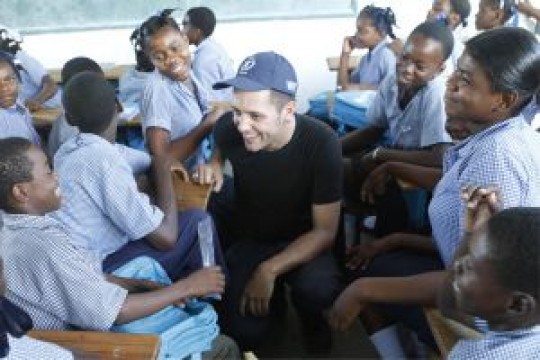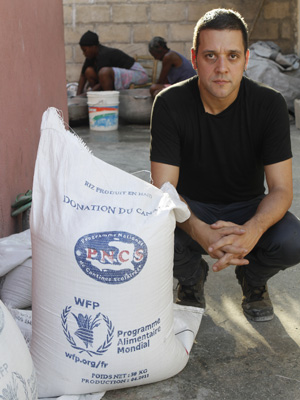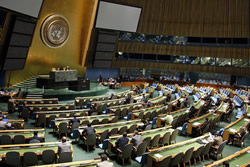Journalist George Stroumboulopoulos Visits Haiti Two Years After Quake
Journalist George Stroumboulopoulos Visits Haiti Two Years After Quake
Almost two years after a devastating earthquake hit Haiti, WFP Ambassador Against Hunger George Stroumboulopoulos went to the Caribbean island to see how the nation was faring. WFP’s Stephanie Tremblay took the Canadian journalist to a camp near Port au Prince where WFP and its partners are helping to fight malnutrition among some of those made homeless by the disaster.
PORT-AU-PRINCE– After luggage was loaded onto the car, everyone went to one of Port-au-Prince’s biggest camps. Nearly two years after the earthquake, Camp Sersal, as the encampment is now called, still houses close to 10,000 people, all of them in tents or temporary shelters.

Here, the World Food Programme works with a Haitian non-governmental organization, the Foundation for the Development of Haitian Families (FONDEFH) to fight malnutrition. WFP and FONDEFH started working in this camp shortly after the earthquake and the health clinic reflects the temporary nature of the settlement. Free medical services are provided in a big tent. “The needs are great, demand is too as we have a lot of cases of moderate malnutrition,” said Dr. Margaret Mallet, the head of FONDEFH.
 When Stroumboulopoulos arrived, dozens of women and young children were waiting to see the nurses. Children aged six months to five years old are weighed and measured to determine whether they suffer from malnutrition. Pregnant or nursing women are also examined, again to see if they are malnourished.
When Stroumboulopoulos arrived, dozens of women and young children were waiting to see the nurses. Children aged six months to five years old are weighed and measured to determine whether they suffer from malnutrition. Pregnant or nursing women are also examined, again to see if they are malnourished.
When the verdict is moderate malnutrition, women and children are enrolled in WFP’s program. They move to a smaller tent next to the first one to receive special fortified food to help them get healthy again. This is a process that women and children will repeat several times to make sure the treatment is efficient.
Every day, the clinic is bustling with people. FONDEFH is working with WFP, but also offers a wide range of medical services supported by UNICEF, USAID, and other partners.
That ad hoc health center has to serve a lot of people and right out of there, you address family nutrition needs and you have the feeding center next to it,” said George Stroumboulopoulos.
In most cases, people who come here have lost their house and their livelihoods in the earthquake. Their financial resources are extremely limited and they say the products they get from the World Food Programme really make a difference in the lives of their families.
The next stop for Stroumboulopoulos and his team was a public school where children were just about to eat a hot meal. Everyday, across Haiti, WFP and its partners provide full meals to 1.1 million schoolchildren.
 I like how the school feeding program is so tied to education so you feel you’re not just addressing an emergency situation. You’re not just feeding somebody because they’re hungry,” George said. “Here, kids are coming, they’re learning, they’re reading, and they’re eating at the same time. Both are feeding into each other. It’s cool to see all of that,” he added.
I like how the school feeding program is so tied to education so you feel you’re not just addressing an emergency situation. You’re not just feeding somebody because they’re hungry,” George said. “Here, kids are coming, they’re learning, they’re reading, and they’re eating at the same time. Both are feeding into each other. It’s cool to see all of that,” he added.
In Haiti, the Government’s objective is to build a universal school meals program that primarily uses local products purchased from small producers. WFP supports the Haitian National School Meals Program and is working towards this objective by developing strong links between local agriculture and schools.
When George Stroumboulopoulos visited École Nationale de Tabarre, bags of rice produced in the South of Haiti and purchased with funds donated by Canada demonstrated how the Government’s objective is already a reality in some of Haiti’s schools.
And at the end of a packed day, what did the Ambassador Against Hunger think of his first visit to Haiti?
Work here appears to be very efficient and I liked how everybody is working together,” he concluded.
### About United Nations World Food Programme (WFP) Fighting hunger worldwide 
The World Food Programme is the world’s largest humanitarian agency fighting hunger worldwide.
“In emergencies, we get food to where it is needed, saving the lives of victims of war, civil conflict and natural disasters. After the cause of an emergency has passed, we use food to help communities rebuild their shattered lives.”
WFP is part of the United Nations system and is voluntarily funded.
Born in 1961, WFP pursues a vision of the world in which every man, woman and child has access at all times to the food needed for an active and healthy life. We work towards that vision with our sister UN agencies in Rome — the Food and Agriculture Organization (FAO) and the International Fund for Agricultural Development (IFAD) — as well as other government, UN and NGO partners.
In 2011 we aim to reach more than 90 million people with food assistance in more than 70 countries. Around 10,000 people work for the organization, most of them in remote areas, directly serving the hungry poor.
WFP’s five objectives:
- Save lives and protect livelihoods in emergencies
- Prepare for emergencies
- Restore and rebuild lives after emergencies
- Reduce chronic hunger and undernutrition everywhere
- Strengthen the capacity of countries to reduce hunger
WFP’s Mission statement
WFP is the food aid arm of the United Nations system. Food aid is one of the many instruments that can help to promote food security, which is defined as access of all people at all times to the food needed for an active and healthy life. ¹ The policies governing the use of World Food Programme food aid must be oriented towards the objective of eradicating hunger and poverty. The ultimate objective of food aid should be the elimination of the need for food aid.
Targeted interventions are needed to help to improve the lives of the poorest people – people who, either permanently or during crisis periods, are unable to produce enough food or do not have the resources to otherwise obtain the food that they and their households require for active and healthy lives.
Consistent with its mandate, which also reflects the principle of universality, WFP will continue to:
- use food aid to support economic and social development;
- meet refugee and other emergency food needs, and the associated logistics support; and
- promote world food security in accordance with the recommendations of the United Nations and FAO.
The core policies and strategies that govern WFP activities are to provide food aid:
- to save lives in refugee and other emergency situations;
- to improve the nutrition and quality of life of the most vulnerable people at critical times in their lives; and
- to help build assets and promote the self-reliance of poor people and communities, particularly through labour-intensive works programmes.
 The United Nations was established on 24 October 1945 by 51 countries committed to preserving peace through international cooperation and collective security. Today, nearly every nation in the world belongs to the UN: membership totals 192 countries.
The United Nations was established on 24 October 1945 by 51 countries committed to preserving peace through international cooperation and collective security. Today, nearly every nation in the world belongs to the UN: membership totals 192 countries.
When States become Members of the United Nations, they agree to accept the obligations of the UN Charter, an international treaty that sets out basic principles of international relations. According to the Charter, the UN has four purposes:
- to maintain international peace and security;
- to develop friendly relations among nations;
- to cooperate in solving international problems and in promoting respect for human rights;
- and to be a centre for harmonizing the actions of nations.
### * The above story is adapted from materials provided by United Nations (UN) ** More information at United Nations (UN) 



















